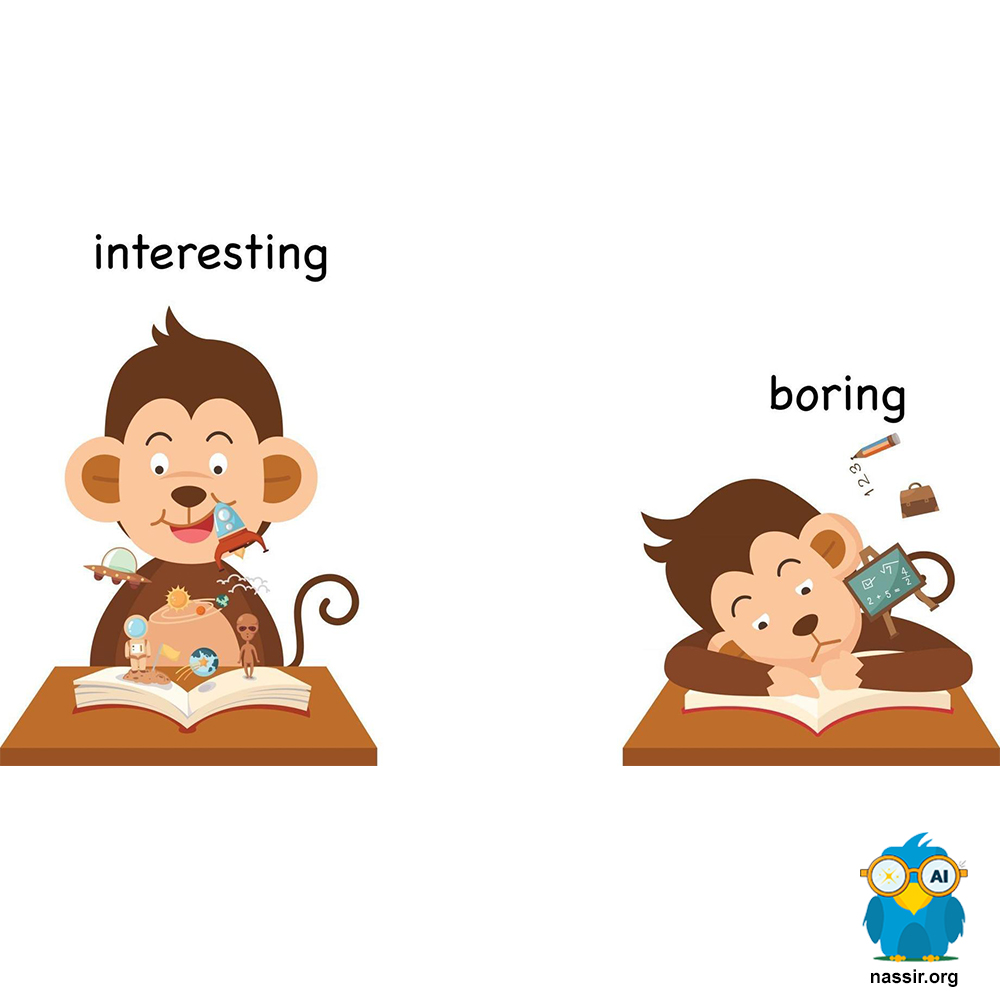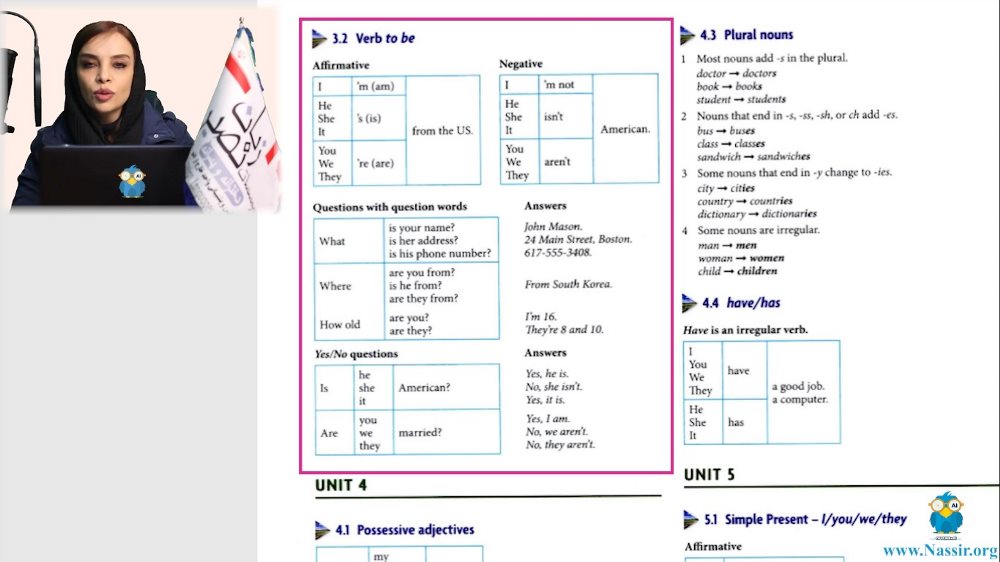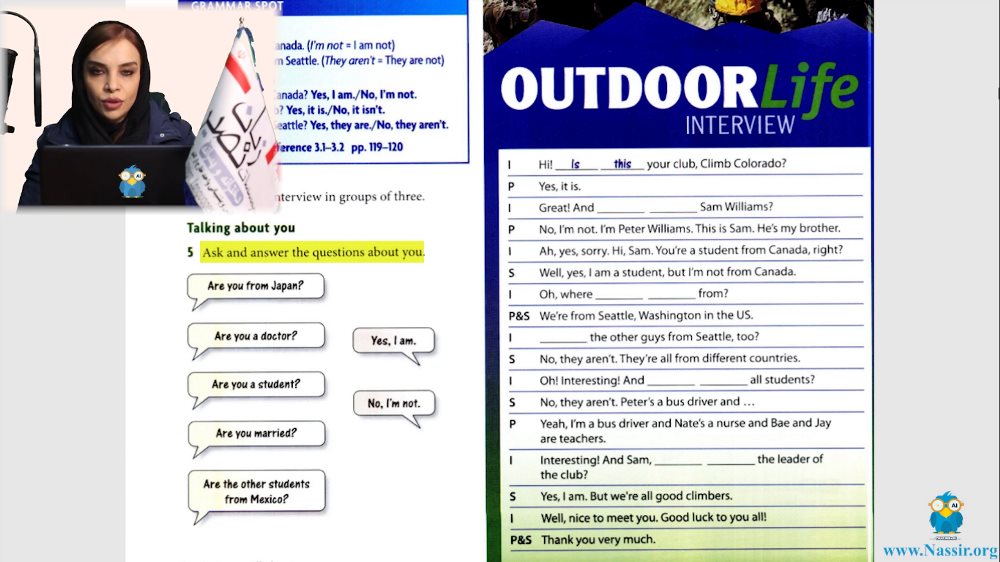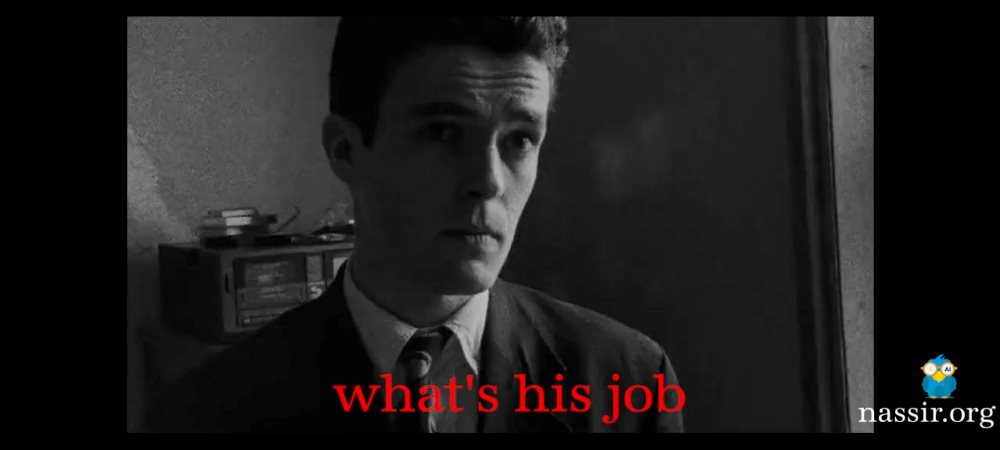جلسه 8 دوره HB1 انگلیسی (رایگان)
اینجا استادای درجهیکمون درس رو با حوصله برات توضیح میدن، مثال میزنن و تمرین میکنن. ما هم تو کتاب برات خط میکشیم، هایلایت میکنیم، معنیها رو مینویسیم و حتی عکسهای جذاب میاریم که درس تو ذهنت حک بشه! بهترین قسمت؟ هرچقدر دوست داری میتونی دوباره ببینی و تکرار کنی تا همه چی برات جا بیفته. خب دیگه وقتشه شروع کنیم. آمادهای؟ بزن بریم
هر سوالی که ممکنه تو ذهنت بیاد رو از هوش مصنوعی پرسیدیم و اینجا جوابش آمادهست! یه نگاهی هم به بقیه سوالا بنداز، شاید برات جالب باشه. راستی اگر بازم سوال داشتی تعارف نکن. تو باکس آخر، سوالتو بپرس. به یک روز نرسیده هوش مصنوعی جوابشو به سوال جوابهای اینجا اضافه میکنه.
-
1 - Why do we say "I’m not" instead of "I amn’t" in "I’m not from Canada"?"
Explanation: "I’m not" is the correct negative form of "I am" (I am not). "I amn’t" is not a standard word in English, though it might seem logical. English uses "not" after "am," "are," or "is" to make negatives, and "I’m not" is the contraction. Examples: "I’m not from Canada." (Correct, from the text.) "I amn’t from Canada." (Incorrect – not a word.) "I’m not a doctor." (Correct negative.)
-
2 - What’s the difference between "Are they from Seattle?" and "Is he from Seattle?"?"
Explanation: "Are they from Seattle?" asks about more than one person (they), using "are" for plural. "Is he from Seattle?" asks about one person (he or she), using "is" for singular. The verb changes based on the subject. Examples: "Are they from Seattle?" "No, they aren’t." (Plural, from the text.) "Is he from Seattle?" "Yes, he is." (Singular, about Sam.) "Is she a student?" "Yes, she is." (Singular.)
-
3 - Why do we answer "No, they aren’t" instead of "No, they not" to "Are they all students?"?"
Explanation: "No, they aren’t" uses "aren’t" (are not) to make a proper negative short answer. "No, they not" is incorrect because it lacks the verb "are." In English, short answers repeat the verb (are/is/am) with "not" for clarity. Examples: "Are they all students?" "No, they aren’t." (From the text.) "No, they not." (Incorrect – missing "are.") "Are you a doctor?" "No, I’m not." (Correct pattern.)
-
4 - What does "His last name is…" mean, and why don’t we say "He’s last name is…"?"
Explanation: "His last name is…" means the family name belongs to him, using "his" (possessive) to show ownership. "He’s last name is…" is incorrect because "he’s" (he is) describes the person, not possession. "His" is needed for names or things he owns. Examples: "His last name is Williams." (Correct, from the text.) "He’s last name is Williams." (Incorrect – wrong structure.) "Her last name is Brooks." (Correct, from Unit 3 earlier.)
-
5 - Can I say "Pedro isn’t from Mexico" instead of "Pedro is from Mexico City" if it’s wrong?"
Explanation: Yes, "Pedro isn’t from Mexico" could be a true negative if he’s not from Mexico country, but the text says "Pedro is from Mexico City," which is specific and correct. Use "isn’t" to deny something, and "is" to confirm. Be specific if you know the right info. Examples: "Is Pedro from Mexico City?" "Yes, he is." (From the text.) "Is Pedro from Canada?" "No, he isn’t." (Negative, fits pattern.) "He isn’t from Seattle." (Negative, like the text.)
-
6 -
چرا میگیم "I’m not" به جای "I amn’t" تو "I’m not from Canada"؟
Why do we say "I’m not" instead of "I amn’t" in "I’m not from Canada"?
Explanation: "I’m not" شکل درست منفی "I am" (من نیستم) هست و کوتاه شدهی "I am not"ه. "I amn’t" تو انگلیسی استاندارد نیست، هرچند منطقی به نظر بیاد. تو منفیها بعد از "am"، "are" یا "is" از "not" استفاده میکنیم. Examples: "I’m not from Canada." (درست، از متن.) "I amn’t from Canada." (غلط – کلمه نیست.) "I’m not a doctor." (منفی درست.)
-
7 -
فرق "Are they from Seattle?" با "Is he from Seattle?" چیه؟
What’s the difference between "Are they from Seattle?" and "Is he from Seattle?"?
Explanation: "Are they from Seattle?" درباره چند نفر (اونا) میپرسه و از "are" برای جمع استفاده میکنه. "Is he from Seattle?" درباره یه نفر (او) میپرسه و از "is" برای مفرد میاد. فعل با فاعل عوض میشه. Examples: "Are they from Seattle?" "No, they aren’t." (جمع، از متن.) "Is he from Seattle?" "Yes, he is." (مفرد، درباره سم.) "Is she a student?" "Yes, she is." (مفرد.)
-
8 -
چرا به "Are they all students?" میگیم "No, they aren’t" نه "No, they not"؟
Why do we answer "No, they aren’t" instead of "No, they not" to "Are they all students?"?
Explanation: "No, they aren’t" از "aren’t" (هستن نه) استفاده میکنه که جواب کوتاه منفی درسته. "No, they not" غلطه چون فعل "are" نداره. تو انگلیسی جواب کوتاه فعل رو با "not" تکرار میکنه که واضح باشه. Examples: "Are they all students?" "No, they aren’t." (از متن.) "No, they not." (غلط – "are" نداره.) "Are you a doctor?" "No, I’m not." (الگوی درست.)
-
9 - "His last name is…" یعنی چی و چرا نمیگیم "He’s last name is…"؟
What does "His last name is…" mean, and why don’t we say "He’s last name is…"?"
Explanation: "His last name is…" یعنی فامیلیش مال اونه و "his" (مال او) نشوندهنده مالکیت اسمشه. "He’s last name is…" غلطه چون "he’s" (او هست) درباره خود شخصه، نه مالکیت. برای اسم یا چیزای خودش از "his" استفاده میکنیم. Examples: "His last name is Williams." (درست، از متن.) "He’s last name is Williams." (غلط – ساختار اشتباه.) "Her last name is Brooks." (درست، از یونیت 3 قبلی.)
-
10 -
میتونم بگم "Pedro isn’t from Mexico" به جای "Pedro is from Mexico City" اگه اشتباه باشه؟
Can I say "Pedro isn’t from Mexico" instead of "Pedro is from Mexico City" if it’s wrong?
Explanation: آره، "Pedro isn’t from Mexico" میتونه منفی درست باشه اگه از کشور مکزیک نباشه، ولی متن میگه "Pedro is from Mexico City" که دقیق و درسته. از "isn’t" برای رد کردن و "is" برای تأیید استفاده کن. اگه اطلاعات دقیق داری، مشخص بگو. Examples: "Is Pedro from Mexico City?" "Yes, he is." (از متن.) "Is Pedro from Canada?" "No, he isn’t." (منفی، مثل الگو.) "He isn’t from Seattle." (منفی، مثل متن.)
فقط دانشجوهایی که توی این کلاس ثبت نام کردن میتونن سوال خودشون رو ثبت کنند
تو این درس لغت جدید دیدی؟ معنیش اینجاست. راحتتر از این نمیشه. دیکشنری آمادهست!
-
Climb
to move up, down, or across something using your feet and hands, especially when this is difficult to do
-
Club
an organization for people who share a particular interest or enjoy similar activities, or a group of people who meet together to do something they are interested in
-
Interview
an official meeting with someone who asks you questions
-
Climber
someone who climbs as a sport
-
Different
not like something or someone else, or not like before OPP similar
-
Interesting
if something is interesting, you give it your attention because it seems unusual or exciting or provides information that you did not know about OPP uninteresting, boring
-
Good luck
used to say that you hope that someone is successful or that something good happens to them\n
-
Businessman
a man who works in business
اینجا برای هر کلمه جدید یه تصویر جذاب داریم که راحتتر یادش بگیری. بزن رو عکس تا کلمهها رو بهتر یاد بگیری! اگر هم دوست داشتی خودتو به چالش بکشی اولش کلمه رو حدس بزن بعد بزن رو عکس ببین چندتاشو درست گفتی.










تلفظ همه لغت های جدید این جلسه رو از هوش مصنوعی گرفتیم و برات اینجا گذاشتیم. برو گوش کن و مثل حرفهایها حرف بزن! هرچقدر هم دوست داشتی میتونی باهاش تکرار کنی.
همه فایلهای صوتی این درس اینجا هست. میتونی گوش کنی و بهتر یاد بگیری!
| 1- 35 | |
| 2- 36 | |
| 3- 37 |
اینجا با کمک هوش مصنوعی کلی فیلم کوتاه از اصطلاحات درس با زیرنویس و تکرار برات آماده کردیم .اینجوری دیگه محاله یادت بره. تا حالا آموزش زبان به این باحالی دیده بودی؟!
اینجا یه عالمه آموزش اضافی باحال از این جلسه گذاشتم که هرچی دلت بخواد توش پیدا میشه. شهر فرنگه اینجا. دیگه چی میخوای؟
اینجا دیگه کامل درس برات جا میفته چون هوش مصنوعی یه عالمه تمرین از این درس برات طرح کرده که میتونی خودتو محک بزنی.استرس نمره نداشته باش، این بخش فقط تمرینه. اگر هم اشتباه گفتی فدای سرت، میتونی دوباره امتحان کنی تا به جواب درست برسی.
توجه
فقط دانشجوهایی که توی این کلاس ثبت نام کردن میتونن در کوئیز شرکت کنند















